Seaside Beach & Meadow
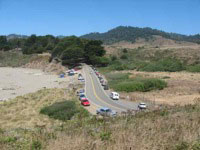 Seaside Beach has a long and varied history, from ancient times as a part of the Yuki Amerindian cultural territories to the pleasant beach parties of the current era. Our stewardship includes honoring the Indian heritage through archaeological study, preserving the various habitats for animals and plants, and enhancing the beach facilities for visitors.
Seaside Beach has a long and varied history, from ancient times as a part of the Yuki Amerindian cultural territories to the pleasant beach parties of the current era. Our stewardship includes honoring the Indian heritage through archaeological study, preserving the various habitats for animals and plants, and enhancing the beach facilities for visitors.
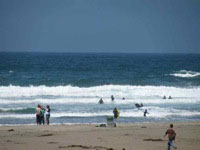 Seaside is a very popular white sand beach just 10 miles north of Fort Bragg. It has a wide sloping beach with a gentle contour and is a safe beach for children and their families. Although no camping is allowed, people can still build a small fire on the sand and enjoy the campfire and outdoor cooking. Skim boarders and occasionally kayakers join the walkers who enjoy the long beach south to Mackerricher State Beach.
Seaside is a very popular white sand beach just 10 miles north of Fort Bragg. It has a wide sloping beach with a gentle contour and is a safe beach for children and their families. Although no camping is allowed, people can still build a small fire on the sand and enjoy the campfire and outdoor cooking. Skim boarders and occasionally kayakers join the walkers who enjoy the long beach south to Mackerricher State Beach.
History and Archaeology
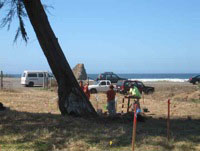 We were fortunate to have a CalTrans project trigger an archaeological study of the area just inside the driveway at the southwest curve. Several test pits were dug to confirm the existence of both historic and prehistoric artifacts around the large single cypress tree. As the layers of soil were peeled back, the scattered remains of the historic residence of the Perry & Amanda Dodge Bowman family were the first to be identified.
We were fortunate to have a CalTrans project trigger an archaeological study of the area just inside the driveway at the southwest curve. Several test pits were dug to confirm the existence of both historic and prehistoric artifacts around the large single cypress tree. As the layers of soil were peeled back, the scattered remains of the historic residence of the Perry & Amanda Dodge Bowman family were the first to be identified.
Amanda Bowman, a Wiyot tribal member, and her extended family lived at the site in the 1900s through the 1960s. Prior to this, the site had been part of the Mendocino Indian Reservation from 1856 to 1866, and a hearth from that time was discovered beneath the Bowman era artifacts. An even earlier discovery of midden articles in the Seaside Creek area indicated that shellfish were harvested there around 1300 A.D. Follow the link for archaeology to read more about the “dig” and the knowledge gained by archaeologist Thad Van Bueren.
Habitats
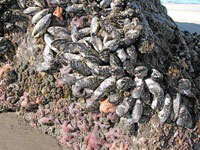 California shorelines offer a wide range of diverse habitats, and Seaside is fortunate to have a good selection of these. Starting at the ocean, the intertidal habitat covers the sandy shore as well as the submerged part of the rocky islands just offshore.
California shorelines offer a wide range of diverse habitats, and Seaside is fortunate to have a good selection of these. Starting at the ocean, the intertidal habitat covers the sandy shore as well as the submerged part of the rocky islands just offshore.
At low tides, the mussels, anemones, starfish and many others are exposed and can be easily viewed by beach lovers.
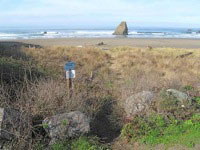 The Coastal Strand and Dunes habitat lines the sandy shore above the tide line.
The Coastal Strand and Dunes habitat lines the sandy shore above the tide line.
Native plants that can withstand the wind, sun, and salt of the strand put down deep roots to hold the plants in place in the sandy soil. Disrupted by wave erosion or trampling, they have been invaded by the exotic European beach grass and ice plant that are so aggressive on the coast. CoLT’s vegetation renewal projects strive to support the native plants while removing the invasive plants.
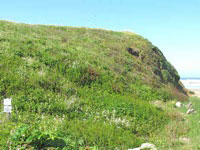 North Coast Bluff Scrub covers most of the south bluff, where better soil allows for the development of brushy species. The water table is quite high, perched on top of a greywacke sandstone, a nonporous sedimentary rock.
North Coast Bluff Scrub covers most of the south bluff, where better soil allows for the development of brushy species. The water table is quite high, perched on top of a greywacke sandstone, a nonporous sedimentary rock.
Most of the plants are low-growing or prostrate as a result of the frequent winds. Common plants include dune buckwheat and wooly sunflower and rare plants include the maple-leafed checkerbloom and Mendocino paintbrush. The plant community intergrades into the strand and dune community at the beach.
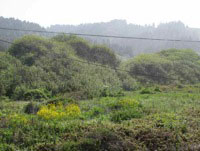 On the eastern side of the highway, North Coast Riparian and meadow wetlands cover the entire parcel. Along Seaside Creek, red alder and willow species dominate, reaching 30’ tall. The meadow itself is floodplain, inundated part of the year. It is dominated by non-native grasses, rushes, water parsley, buttercup and silverleaf potentilla. A small marsh lies near the roadway with a gradient of brackish to fresh water, wetland plants and willows.
On the eastern side of the highway, North Coast Riparian and meadow wetlands cover the entire parcel. Along Seaside Creek, red alder and willow species dominate, reaching 30’ tall. The meadow itself is floodplain, inundated part of the year. It is dominated by non-native grasses, rushes, water parsley, buttercup and silverleaf potentilla. A small marsh lies near the roadway with a gradient of brackish to fresh water, wetland plants and willows.
The Seaside Stewards, a volunteer group meeting monthly, helps to maintain the valuable habitats by doing invasive species removal and beach cleanup. Read more on the stewardship page.
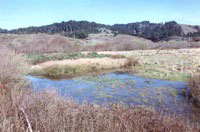 A botanical survey of the Seaside habitats was conducted in 2000 by Prof. Teresa Sholars, and can be downloaded from the research page.
A botanical survey of the Seaside habitats was conducted in 2000 by Prof. Teresa Sholars, and can be downloaded from the research page.
Invasive Plant Removal
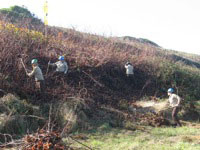 The invasive Giant Knotweed was first noticed in 1997 as a ten-foot-square patch of tall leafy stalks along the highway. By 2007 the patch had grown to 120’ long, 40’ wide, and 6’ high, and was multiplying fast.
The invasive Giant Knotweed was first noticed in 1997 as a ten-foot-square patch of tall leafy stalks along the highway. By 2007 the patch had grown to 120’ long, 40’ wide, and 6’ high, and was multiplying fast.
CoLT contacted the State Coastal Conservancy for help in funding a invasive plant removal project. Combined with a facilities improvement effort, the project started to remove the knotweed.
First the Civilian Conservation Corps cut down the plants and then the roots were covered with a huge black tarp. This approach relied on light deprivation to debilitate the rhizomous roots enough to allow for hand removal.
CoLT emphasizes non-herbicide treatments, and was determined to remove the knotweed without the use of chemicals near our wetlands. After the root mass was considerably depleted, the Vegetation Specialist Carrie Durkee took on the task of digging up the roots.
With the help of the Civilian Conservation Corps and the Mendocino Coast Weed Management Area, a crew of determined workers have pursued and burned the roots for many months, until the hillside no longer shows sprouts of knotweed. See our knotweed page for more about this incredible success. (They said it Couldn’t Be Done!)